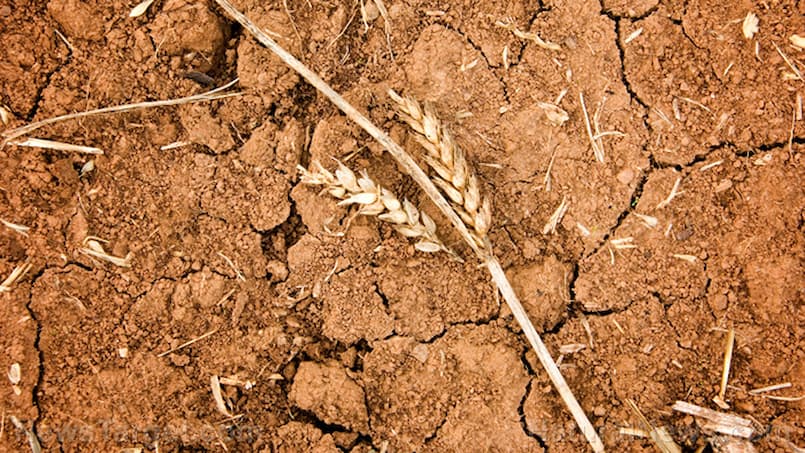(Ethan Huff) An unexpected blast of extreme heat in India – a highly unusual event this early in the season – has taken out a sizable amount of the country’s wheat crop.
Related A Triple-Whammy For Food Prices — How to Prepare For The Worst
by Ethan Huff, May 3rd, 2022
The second-most populous country in the world is now attempting to assess the damage, and experts worry that India may have to increase its imports to make up for yield shortfalls that will occur come harvest time.
Will this be possible, though? The world is already reeling from a supply chain shock linked to Russia’s war in Ukraine. Both Russia and Ukraine are heavy exporters of wheat and other food crops, and both nations are now capping or banning exports as part of new protectionist measures.
The heatwave that swept India in March is the hottest on record since the country first started tracking weather patterns back in 1901. Normally, March is a cooler time period, which makes for good wheat harvests – but not this year.
“Wheat is very sensitive to heat, especially during the final stage when its kernels mature and ripen,” reports The Associated Press (AP). “Indian farmers time their planting so that this stage coincides with India’s usually cooler spring.”
India’s “grain bowl” region may not produce enough this year to supply the country’s national reserves with food
A London-based “climate scientist” is blaming global warming for India’s heatwave. Friederike Otto from Imperial College London says that human activities are to blame for the failed wheat crops.
“But now it is a much more common event,” Otto is quoted as saying about how there have always been heatwaves, but they are supposedly much more common now that humans have advanced technologically.
From 1990 to 2019, according to a 2021 report published in the medical journal The Lancet, India’s vulnerability to extreme heat increased by about 15 percent.“We can expect such high temperatures about once in every four years,” he added.
“It is among the top five countries where vulnerable people, like the old and the poor, have the highest exposure to heat,” the AP added. “It and Brazil have the highest heat-related mortality in the world, the report said.”
In the northern Indian state of Punjab, one farmer said he lost about a fifth of his wheat yield due to the recent heatwave. Others in his area lost much more – and they are not even out of the woods yet.
“I am afraid the worst is yet to come,” said Baldev Singh.
Punjab is India’s “grain bowl,” much like how Ukraine is Europe’s “breadbasket.” A large percentage of India’s food comes from Punjab, as the government has been encouraging the cultivation of both wheat and rice throughout the region since the 1960s.
Punjab is usually the largest contributor to India’s national reserves. The government of India was hoping to snap up about a third of its stock from the Punjab region, but that may no longer be possible due to the heatwave.
Devinder Sharma, an agriculture policy expert in the northern Indian city of Chandigarh, says he expects the government to receive about 25 percent less grain from the Punjab region this season.
“Overall, India purchased over 43 million metric tons (47.3 million U.S. tons) of wheat in 2021,” the AP further reported. “Sharma estimates it will instead get 20% to nearly 50% less.”
“Even though it is the world’s second-largest producer of wheat, India exports only a small fraction of its harvest. It had been looking to capitalize on the global disruption to wheat supplies from Russia’s war in Ukraine and find new markets for its wheat in Europe, Africa, and Asia.”
[the_ad_group id=”25840″]
Stillness in the Storm Editor: Why did we post this?
The news is important to all people because it is where we come to know new things about the world, which leads to the development of more life goals that lead to life wisdom. The news also serves as a social connection tool, as we tend to relate to those who know about and believe the things we do. With the power of an open truth-seeking mind in hand, the individual can grow wise and the collective can prosper.
– Justin
Not sure how to make sense of this? Want to learn how to discern like a pro? Read this essential guide to discernment, analysis of claims, and understanding the truth in a world of deception: 4 Key Steps of Discernment – Advanced Truth-Seeking Tools.
Stillness in the Storm Editor’s note: Did you find a spelling error or grammatical mistake? Send an email to corrections@stillnessinthestorm.com, with the error and suggested correction, along with the headline and url. Do you think this article needs an update? Or do you just have some feedback? Send us an email at sitsshow@gmail.com. Thank you for reading.
Source:
[the_ad id=”121669″]

Leave a Reply